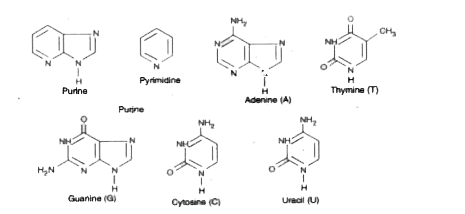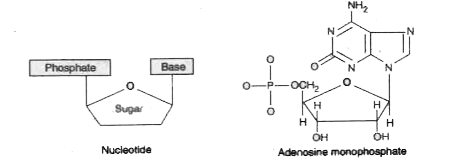(a) What are nucleic acids ? How are they classified ?
(b) What are its structural building blocks ?
Text Solution
(a) Nucleic acids. These are the biologically significant polymers which are present in all the living cells. They direct the synthesis of proteins and are responsible for the transfer of genetic information i.e. the hereditary characteristics. The repeating units of nucleic acids are called nucleotides. Nucleic acids are, therefore, also called polynucleotides.
There are two types of nucleic acids :
(i) DNA (deoxyribonucleic acid)
(ii) RNA (ribonucleic acid)
(b) Nucleic acids are polymers whose repeating units are called nucleotides. Each nucleotide unit has three components :
(i) A nitrogen containing heterocyclic base. These are two types of compounds known as purines or pyrimidines. The heterocycles present in nucleic acid are substituted forms of these compounds. The common examples are :
(A) adenine (G) and guanine are substituted purines (C) cytosine, thymine (T) and uracil (U) are substituted pyrimidines.
The structures of these compounds are shown below :

The purine adenine and guanine and substituted pyrimidine (cytosine) are found in both polymers DNA and RNA . However, RNA contains uracil instead of thymine present in DNA.
(ii) A pentose sugar like ribose or deoxyribose . Their structures are shown in fig.

As the implies , DNA polymers contain deoxyribose sugar rings while RNA polymers contains ribose sugar rings.
(iii) A phosphate group. These are responsible for the linkage in nucleic acid polymers.
In nucleic acid the sugar rings are attached to the nitrogen atom of the heterocycle by a bond between C1 atom of sugar and nitrogen atom of heterocycle. This linkage is called glycosidic bond and these compounds are called nucleosides. When the phosphate groups attached to the nucleoside, the compound formed is called nucleotide. Their structures are shown below:

|
Updated on:21/07/2023
Related Playlists
- BOOK - MBD -HARYANA BOARDCHAPTER - BIOMOLECULESEXERCISE - SHORT ANSWER TYPE QUESTIONS26videos
BIOMOLECULES
- BOOK - MBD -HARYANA BOARDCHAPTER - ALDEHYDES, KETONES AND CARBOXYLIC ACIDSEXERCISE - LONG ANSWER TYPE QUESTIONS8videos
ALDEHYDES, KETONES AND CARBOXYLIC ACIDS
- BOOK - MBD -HARYANA BOARDCHAPTER - BOARD QUESTION PAPER -2019 (SOLVED )EXERCISE - LONG ANSWER TYPE QUESTIONS6videos
BOARD QUESTION PAPER -2019 (SOLVED )
Similar Questions
Amino acids are building blocks of
View SolutionWhat are interhalogen compounds ? How are they classified? Give the structure of IF7.
View SolutionWhat are the structural units of nucleic acids?
View SolutionWhat are the structural units of nucleic acids?
View SolutionAmino acids are the building blocks of
View SolutionAmino acids are the building block of
View SolutionWhat are building blocks of proteins ?
View SolutionWhat are building blocks of nucleic acids ?
View Solution(a) What are nucleic acids and enzymes ?
(b) Write the chemical name of vitamin D.View SolutionWhat are nucleic acids ? Mention their two important functions.
View Solution

